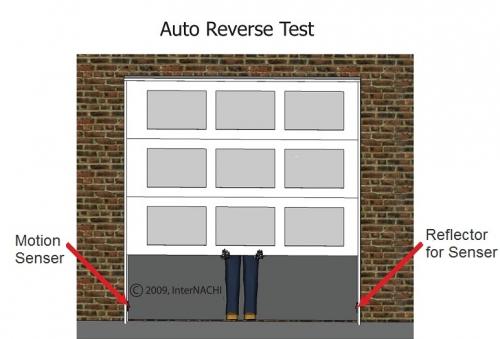Do you ever wonder how a garage door opener knows when to stop closing and reverse direction? Well, today we’re going to explore just that and learn how to test the reversing mechanism on a garage door opener. So buckle up, get ready for an exciting ride, and let’s dive into the world of garage door openers!
Now, you might be thinking, “Why should I bother testing the reversing mechanism?” Well, my friend, it’s all about safety. We want to ensure that our garage doors will reverse if they encounter any obstacles, preventing accidents and injuries. So, let’s be proactive and make sure our garage door openers are up to the task.
Testing the reversing mechanism is an essential maintenance task that ensures the safety of your garage door and everyone around it. In our next paragraphs, we’ll walk you through the step-by-step process, so you can test your garage door opener with confidence and peace of mind. Are you ready? Let’s get started!
- Ensure the garage door is fully open.
- Place a 2×4 block on the floor, directly under the door.
- Activate the door to close using the opener.
- When the door touches the block, it should reverse immediately.
- If the door does not reverse, adjust the opener’s force settings or consult the manufacturer.

How to Test the Reversing Mechanism on a Garage Door Opener: A Comprehensive Guide
Garage door openers are an essential convenience in modern homes, allowing easy access to your garage without the need to manually open and close the door. However, it’s crucial to ensure that the reversing mechanism on your garage door opener is functioning correctly. This mechanism is designed to detect any obstruction and automatically reverse the door’s movement to prevent accidents or damage. In this comprehensive guide, we will walk you through the steps of testing the reversing mechanism on a garage door opener to ensure its safe and efficient operation.
Why Testing the Reversing Mechanism is Important
Regularly testing the reversing mechanism on your garage door opener is vital for the safety of your family and possessions. Faulty or malfunctioning mechanisms can pose serious risks, such as the door failing to detect an obstruction and causing damage to property or, worse, injuring someone. A properly functioning reversing mechanism ensures that the door will stop and reverse its movement if it encounters any object or person in its path. By performing this test periodically, you can be confident that your garage door opener is in good working condition and provides a safe environment for you and your loved ones.
Steps to Test the Reversing Mechanism on a Garage Door Opener
1. Clear the area: Before you begin the testing process, make sure the area around the garage door is clear of any objects or obstructions. This includes vehicles, tools, and other items that may interfere with the door’s movement.
2. Close the door: Close the garage door fully and ensure it is securely latched. This will provide a starting point for the reversing mechanism test.
3. Place an obstacle: Place a large object, such as a sturdy cardboard box or a roll of carpet, in the path of the closing door. Position it so that it covers the door’s photo-eye sensors, which are usually located near the bottom of the door tracks. These sensors are designed to detect obstructions and trigger the reversing mechanism.
4. Test the downward movement: Press the button on your garage door opener to close the door. Observe the door’s movement and listen for any unusual sounds. The door should come into contact with the obstruction and reverse its movement within a few seconds. If the door continues to close without reversing, immediately release the button to halt the operation.
5. Remove the obstacle: Clear the path of the door by removing the obstacle. Make sure there are no other obstructions in the door’s path.
6. Test the upward movement: Press the button on your garage door opener to open the door. Observe the door’s movement and listen for any unusual sounds. As the door reaches its fully open position, place a solid object, such as a wooden block, on the floor in the path of the door. The door should detect the obstruction and reverse its movement within a few seconds. If it fails to reverse, release the button to stop the operation immediately.
7. Repeat the test: Perform the above steps at least two more times to ensure consistent results. This will help identify any intermittent issues with the reversing mechanism.
Common Issues and Troubleshooting Tips
1. Door Fails to Reverse
If the garage door fails to reverse after contacting an obstruction, there could be an issue with the reversing mechanism. Check the photo-eye sensors for any dirt or obstructions that may be blocking the infrared beam. Clean the sensors with a soft, lint-free cloth and align them properly. If the problem persists, consult a professional technician to inspect and repair the reversing mechanism.
2. Door Reverses Too Late or Too Slow
If the door reverses later than expected or at a slow pace, the force settings on the garage door opener may need adjustment. Consult the manufacturer’s manual for instructions on adjusting the force. It is also essential to ensure that the door’s track and rollers are clean and properly lubricated to ensure smooth movement.
3. Inconsistent Reversing
If the garage door opener’s reversing mechanism works intermittently, it could indicate a faulty wiring connection or a damaged sensor. Inspect the wires for any signs of damage, such as frayed or loose connections, and repair or replace them as necessary. If the issue persists, it’s best to seek professional help to diagnose and resolve the problem.
Regular Maintenance Tips for Garage Door Openers
To keep your garage door opener in optimal condition and ensure the effective functioning of the reversing mechanism, follow these maintenance tips:
1. Lubricate the moving parts: Apply a silicone-based lubricant to the hinges, rollers, and springs of the garage door to minimize friction and smooth out the door’s movement. Avoid using WD-40 or other petroleum-based lubricants, as they can attract dirt and cause buildup over time.
2. Test the safety features: In addition to testing the reversing mechanism, periodically check the other safety features of your garage door opener, such as the emergency release mechanism and the auto-reverse feature. These features can help prevent accidents and injuries.
3. Keep the photo-eye sensors clean: Regularly clean the photo-eye sensors to ensure their proper operation. Remove any dirt, dust, or debris that may be blocking the infrared beam between the sensors.
4. Inspect the door’s balance: Check the balance of the garage door by disconnecting the opener and manually opening it halfway. If the door stays in place, it is properly balanced. If it moves up or down, it may require adjustment by a professional technician.
5. Schedule professional maintenance: Consider scheduling an annual maintenance service with a garage door professional. They will inspect, lubricate, and adjust the various components of your garage door opener to ensure smooth and reliable operation.
By following these steps and regularly maintaining your garage door opener, you can have peace of mind knowing that the reversing mechanism is functioning correctly and your garage is safe for use. Remember to consult a professional technician for any complex issues or repairs to ensure the longevity and optimal performance of your garage door opener.
Key Takeaways – How to Test the Reversing Mechanism on a Garage Door Opener?
- Test the reversing mechanism by placing a 2×4 board or a roll of paper towels on the garage floor.
- Close the garage door using the remote or wall button.
- When the garage door touches the board or paper towels, it should immediately reverse and go back up.
- If the door does not reverse, it could indicate a problem with the reversing mechanism that needs to be addressed.
- Regularly test the reversing mechanism to ensure the safety of people and pets around the garage door.
Frequently Asked Questions
Welcome to our frequently asked questions section where we will answer some common questions related to testing the reversing mechanism on a garage door opener.
1. Why is it important to test the reversing mechanism on a garage door opener?
Testing the reversing mechanism on a garage door opener is crucial for safety reasons. The reversing mechanism is designed to prevent the door from closing on people, pets, or objects that may be in its path. Regularly testing this mechanism ensures that it is functioning correctly and can help prevent accidents or injuries.
By testing the reversing mechanism, you can identify any issues early on and take the necessary steps to repair or maintain the opener. It also gives you peace of mind knowing that your garage door is operating safely and that you are taking the necessary precautions to protect yourself and others.
2. How can I test the reversing mechanism on my garage door opener?
To test the reversing mechanism on your garage door opener, start by placing a 2×4 piece of wood flat on the ground in the path of the closing door. Close the door using the garage door opener and observe its behavior. The door should automatically reverse within two seconds of coming into contact with the wood.
If the door doesn’t reverse or only partially reverses, you might need to adjust the force sensitivity settings of your opener. Refer to the manufacturer’s instructions for information on how to do this. It’s important to note that if your garage door opener fails any part of the reversing mechanism test, it should be checked and repaired by a professional technician.
3. How often should I test the reversing mechanism on my garage door opener?
It is recommended to test the reversing mechanism on your garage door opener at least once every month. However, it’s a good idea to perform the test more frequently if you use your door frequently or if there have been any changes to the opener’s performance or behavior.
In addition to regular monthly tests, you should also test the reversing mechanism after any maintenance or repairs have been done on the opener or the door itself. It’s better to be safe than sorry, so make sure to incorporate this simple test into your regular home maintenance routine.
4. What should I do if the reversing mechanism on my garage door opener fails the test?
If the reversing mechanism on your garage door opener fails the test, it’s important not to ignore the issue. The first step is to consult the manufacturer’s manual or contact their customer support for troubleshooting advice specific to your opener model.
If you are unable to resolve the issue on your own, it is recommended to contact a professional garage door technician. They have the expertise to diagnose and fix the problem safely. Continuing to use a garage door opener with a faulty reversing mechanism can be dangerous and put you and your loved ones at risk.
5. Can I perform the test on a garage door opener myself, or should I hire a professional?
Performing the test on a garage door opener’s reversing mechanism is something you can do yourself. The test is relatively simple and requires no special tools. However, if you are unsure about any aspect of the test or if the reversing mechanism fails, it is advisable to consult a professional.
A professional garage door technician has the necessary experience and knowledge to troubleshoot and fix any issues that may arise during the test. They can ensure that your opener is functioning correctly and that all safety measures are in place. It’s always better to seek professional help when in doubt to guarantee the safety and proper functioning of your garage door opener.

Summary
Here’s a quick recap of what we’ve learned about testing the reversing mechanism on a garage door opener. First, make sure that the safety sensors are properly aligned and clean. Then, perform a simple test by closing the garage door and placing an object in its path. If the door doesn’t reverse when it touches the object, you may need to adjust the sensitivity settings. Lastly, consult the user manual or contact a professional if you’re unsure about any step or if the reversing mechanism still doesn’t work properly. Stay safe and happy garage door testing!
In conclusion, testing the reversing mechanism on a garage door opener involves checking the safety sensors, performing a simple test with an object, and adjusting the sensitivity if needed. Remember to consult the manual or seek professional help if you have any doubts. Stay safe!

